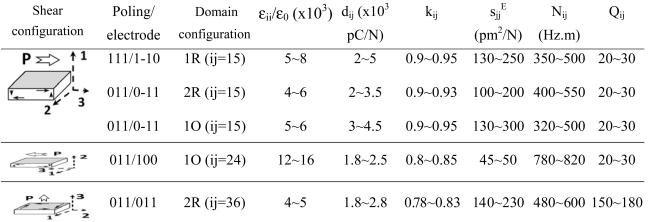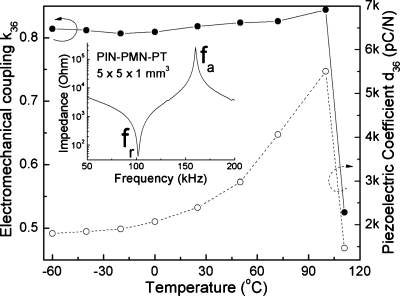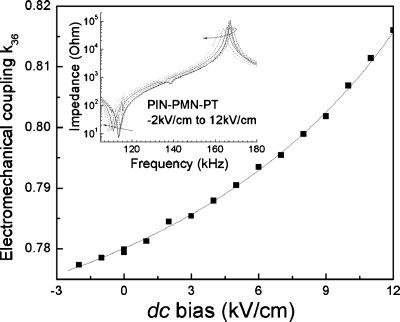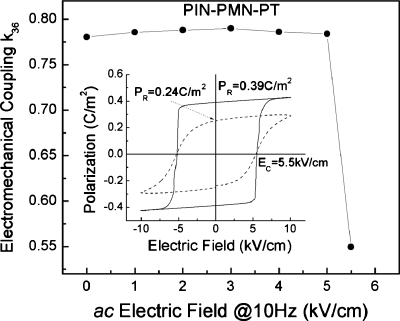Abstract
Poling relaxor-PbTiO3 single crystals along pseudocubic [011] results in a macroscopic symmetry of mm2, enabling a large face shear d36 in Zt±45° cut crystals. In order to allow the determination of electrical properties by the resonance method, square samples are required. Using Pb(In0.5Nb0.5)O3–Pb(Mg1∕3Nb2∕3)O3–PbTiO3 crystals, piezoelectric d36 coefficients were determined to be in the range of 2000–2500 pC∕N, with electromechanical coupling factor k36∼0.80–0.83. Mechanical quality factor Q∼180 and ultralow frequency constant of ∼500 Hz m were obtained. Together with the wide temperature usage range (up to ∼110 °C) and high ac driving field stability (∼5 kV∕cm), such face shear crystals have a promising potential for ultralow-frequency-transducer applications.
The excellent electromechanical properties of relaxor-PT single crystals, including Pb(Mg1∕3Nb2∕3)O3–PbTiO3 (PMNT) and Pb(In0.5Nb0.5)O3–Pb(Mg1∕3Nb2∕3)O3–PbTiO3 (PIN-PMN-PT), have attracted considerable attention over the past two decades.1, 2, 3, 4 It has been reported that large longitudinal piezoelectric coefficients, d33>1500 pC∕N and electromechanical coupling, k33>0.90, can be achieved for rhombohedral crystals when poled along the pseudocubic [001] direction, resulting in an engineered domain configuration with the macroscopic symmetry of 4mm.5 Furthermore, high extensional piezoelectric coefficients, −d32>1200 pC∕N and coupling factor, k32>0.85 are possible for crystals poled along [011], with a macroscopic symmetry of mm2.6 For thickness shear piezoelectric properties, however, the scenario is complicated. As listed in Table 1, large shear piezoelectric, d15>2000 pC∕N is obtained for rhombohedral (R) crystals poled along their spontaneous polarization direction [111] (3m symmetry with single domain state “1R”), with an electromechanical coupling factor k15>0.9,7, 8, 9, 10 while high shear piezoelectric d15 and d24 are observed in [011] poled orthorhombic (O) crystals (mm2 symmetry with single domain configuration “1O”),11 related to the “facilitation” of polarization rotation in the single domain states.12, 13 In [011] poled R crystals (mm2 symmetry with multi domain state “2R”), however, only large d15 was observed, on the order of >2000 pC∕N, with much lower d24 values, ∼200 pC∕N,11, 12, 13, 14 due to the negated shear deformation strain in the “2R” domain engineered structures.11 Relevant to this work, the [011] poled R crystals also possess a large face shear piezoelectric coefficient, d36, as high as 2600 pC∕N, in a rotated coordinate system (rotation angle of 45° around the poling axis Z-[011]), which was confirmed by a quasistatic method using a Berlincourt meter.15 In contrast to conventional thickness shear d15, the face shear vibration mode can be repolarized, i.e., the poling electrode is the same as the active electrode.15, 16 To date, no studies have been carried out on the measurement of face shear piezoelectric properties using the resonance method, owing to the coupling of spurious vibration modes. Thus, parameters, including electromechanical coupling factor, k36, mechanical quality factor, Q36 and frequency constant, N36, which are essential for transducer design, have yet to be confirmed. The use of the resonance method also allows properties to be determined as a function of temperature and under dc∕ac fields. In this work, the dielectric, piezoelectric, and electromechanical properties of the face shear vibration mode in relaxor-PT crystals were investigated. The temperature and dc∕ac bias dependent behavior were evaluated to establish domain stability under high field drive condition.
Table 1.
Principle face shear properties of [011] poled Zt±45° cut PIN-PMN-PT crystals, compared to conventional thickness shear properties.
 | |
For this study, rhombohedral PIN-PMN-PT crystals were used, owing to their relatively high usage temperature range (rhombohedral to tetragonal phase transition TRT∼120 °C) and large coercive field (EC≥5 kV∕cm), compared to their binary PMNT counterpart.2 The compositions of the investigated crystals were near the R∕O phase boundary, with Curie temperature TC∼180–190 °C and TRO∼95–110 °C. The obtained crystals were oriented along [011] and [100] directions using a real-time back-reflection Laue system. The samples were gold electroded on (011) faces, and poled under 10 kV∕cm field at room temperature. Face shear samples were prepared by rotating a 45° angle about the Z-axis ([011] poling direction) and designated as Zt±45° cut. Various aspect ratios of samples were investigated, from 20:20:1 to 20:2:1. It was found that samples with the square shape aspect ratio (e.g., 5×5×1 mm3) possess a clean face shear vibration mode. The capacitance and dielectric loss were determined using an HP4284A multifrequency LCR meter while the resonance and antiresonance frequencies of the face shear vibration modes were recorded by an HP4294A impedance-phase gain analyzer. From the frequency spectra, the frequency constant N36, elastic compliance , mechanical quality factor Q, and the coupling k36 were calculated. The calculations were based on the IRE standard17 combined with a simplified model,18 where the displacements of vibration are deemed to only perpendicular to the wave propagation direction. Although the theoretical models are approximate, the errors are acceptable, being less than 6% for coupling while it is only <3% for piezoelectric coefficient and elastic compliance. High field measurements of the polarization were performed using a modified Sawyer–Tower circuit, at frequency of 10 Hz under a 10 kV∕cm field. A blocking circuit was used to protect the HP4294 impedance analyzer from high voltage during the dc bias tests. For ac driving field stability evaluation, the samples were first electrically cycled at various field levels at 10 Hz, then resonance and antiresonance frequencies were measured after 5000 cycles.
The principle properties related to the face shear vibration mode for PIN-PMN-PT crystals determined in this work are reported in Table 1, and compared to conventional thickness shear properties.9, 11, 13, 14, 19, 20, 21 The dielectric constant for the studied crystals was found to be in the range from 4500 to 5200, while the dielectric loss is in the range of 0.1%–0.2%. The elastic compliance and piezoelectric coefficient d36 were found to be on the order of 160–200 pm2∕N and 2000–2500 pC∕N, respectively, with electromechanical coupling factor, k36, being 0.80–0.83. The property variations observed in all the shear vibration modes are closely related to the crystal composition, following the general trend of relaxor-PT crystals, i.e., the higher TRO temperature, the lower dielectric and piezoelectric properties.2 Ultralow face shear frequency constant, N36∼500 Hz m, was obtained, which is similar to the values of thickness shear modes, ∼350–600 Hz m.19 For the case of face shear mode, however, the frequency constant refers to the large dimension (length) of the samples, making it possible to realize ultra-low frequency transducers with a small volume.20 It is important to note that the mechanical quality factors, Q’s, obtained for the face shear crystals, were on the order of 150–180 (higher Q∼450 was observed in samples with different aspect ratio), significantly higher than those of the thickness shear modes, ∼20–30. The low mechanical Q is believed to be related to the ease of polarization rotation in corresponding thickness shear cuts.21
The temperature dependence of the coupling factor k36 and piezoelectric d36 coefficient for PIN-PMN-PT crystals are presented in Fig. 1. As shown in the figure, the coupling factor k36 is 0.81 at −60 °C, increases slightly to 0.84 at the temperature of 100 °C, the associated R∕O phase transition temperature, above which the coupling factor decreases to 0.52, the value associated with single domain orthorhombic crystals. Correspondingly, the piezoelectric coefficient d36 was ∼1800 pC∕N at −60 °C, gradually increases to 2400 pC∕N at room temperature, and reaches as high as 5500 pC∕N at the phase transition temperature. As expected, the temperature variation in the piezoelectric coefficients follows the trend as earlier reported d32 and d31 extensional modes.6
Figure 1.
Face shear coupling k36 and piezoelectric d36 of PIN-PMN-PT crystals as a function of temperature. The small inset shows typical impedance characteristics for a face shear vibration mode of a square plate.
Figure 2 presents the electromechanical coupling factor, k36, as a function of dc bias field. The impedance spectra under various dc bias fields are given in the inset, where the resonance frequency was found to shift downward with increasing dc bias, indicating elastic “softening.” From the figure, the coupling factor was found to be ∼0.815 at a field of −2 kV∕cm, and gradually increasing to 0.850 at 12 kV∕cm. This increase is due to the fact that the applied dc bias is along the [011] direction, which further stabilized the orthorhombic phase, leading to easier polarization rotation from [111] to [011]. As expected, the effect of a negative dc bias on the order of half coercive field (∼3 kV∕cm), results in a drastic decrease in the coupling factor or depolarization. Figure 3 presents the electromechanical coupling factor, k36, as function of ac driving field level, with k36 maintaining a level of 0.83 until the ac field reaches ∼5 kV∕cm. The small inset in Fig. 3 shows the polarization hysteresis loops measured at 10 kV∕cm for [011] oriented PIN-PMN-PT crystals before and after the 5000 electrical cycles at 5.5 kV∕cm at 10 Hz. The polarization loop observed after the cycling was skewed in shape, with the remnant polarization PR being on the order of 0.24 C∕m2, which is much smaller than that of a virgin sample ∼0.39 C∕m2, indicating fatigue caused property degradation.22 It is interesting to note that the allowable ac drive field for face shear crystals is on the level of the coercive field, which is significantly more stable than that reported in the thickness shear crystals, only ∼2 kV∕cm in PIN-PMN-PT, due to the repolarizable characteristics in face shear samples.15, 19
Figure 2.
Electromechanical coupling k36 as a function of dc bias field for PIN-PMN-PT crystals. Small inset shows the impedance characteristics as a function of dc bias.
Figure 3.
Electromechanical coupling k36 as function of ac drive field for PIN-PMN-PT crystals. The small inset shows the polarization hysteresis for virgin (solid line) and fatigued (dotted line) crystals.
In summary, the face shear piezoelectric properties achieved in [011] poled PIN-PMN-PT crystals were investigated using the resonance method on Zt±45° cut square plates. As general observation, the large piezoelectric coefficient d36>2000 pC∕N, high electromechanical coupling factor k36>0.80, ultralow frequency constant ∼500 Hz.m, together with a relatively wide temperature usage range and high allowable ac drive field, make face shear relaxor-PT single crystals promising candidates for low frequency broadband ultrasonic transducers.
Acknowledgments
The work supported by NIH under Grant No. P41-EB21820 and the ONR.
References
- Park S. -E. and Shrout T. R., J. Appl. Phys. 82, 1804 (1997). 10.1063/1.365983 [DOI] [Google Scholar]
- Zhang S. J. and Shrout T. R., IEEE Trans. Ultrason. Ferroelectr. Freq. Control 57, 2138 (2010). 10.1109/TUFFC.2010.1670 [DOI] [PMC free article] [PubMed] [Google Scholar]
- Luo H., Xu G., Xu H., Wang P., and Yin Z., Jpn. J. Appl. Phys., Part 1 39, 5581 (2000). 10.1143/JJAP.39.5581 [DOI] [Google Scholar]
- Damjanovic D., IEEE Trans. Ultrason. Ferroelectr. Freq. Control 56, 1574 (2009). 10.1109/TUFFC.2009.1222 [DOI] [PubMed] [Google Scholar]
- Zhang S., Luo J., Hackenberger W., and Shrout T., J. Appl. Phys. 104, 064106 (2008). 10.1063/1.2978333 [DOI] [PMC free article] [PubMed] [Google Scholar]
- Zhang S. J., Juo J., Hackengerger W., Sherlock N., R. J.Meyer, Jr., and Shrout T. R., J. Appl. Phys. 105, 104506 (2009). 10.1063/1.3131622 [DOI] [PMC free article] [PubMed] [Google Scholar]
- Zhang S., Lebrun L., Rhee S., Randall C., and Shrout T., Appl. Phys. Lett. 81, 892 (2002). 10.1063/1.1497435 [DOI] [Google Scholar]
- Zhang R., Jiang B., and Cao W., Appl. Phys. Lett. 82, 3737 (2003). 10.1063/1.1576510 [DOI] [Google Scholar]
- Liu X., Zhang S., Luo J., Shrout T., and Cao W., Appl. Phys. Lett. 96, 012907 (2010). 10.1063/1.3275803 [DOI] [PMC free article] [PubMed] [Google Scholar]
- Damjanovic D., Budimir M., Davis M., and Setter N., Appl. Phys. Lett. 83, 527 (2003). 10.1063/1.1592880 [DOI] [Google Scholar]
- Zhang S. J., Li F., Luo J., Xia R., Hackenberger W., and Shrout T. R., Appl. Phys. Lett. 97, 132903 (2010). 10.1063/1.3494532 [DOI] [PMC free article] [PubMed] [Google Scholar]
- Budimir M., Damjanovic D., and Setter N., J. Appl. Phys. 94, 6753 (2003). 10.1063/1.1625080 [DOI] [Google Scholar]
- Li F., Zhang S., Xu Z., Wei X., Luo J., and Shrout T., Appl. Phys. Lett. 97, 252903 (2010). 10.1063/1.3529952 [DOI] [PMC free article] [PubMed] [Google Scholar]
- Sun E., Zhang S., Luo J., Shrout T., and Cao W., Appl. Phys. Lett. 97, 032902 (2010). 10.1063/1.3466906 [DOI] [PMC free article] [PubMed] [Google Scholar]
- Han P., Yan W., Tian J., Huang X., and Pan H., Appl. Phys. Lett. 86, 052902 (2005). 10.1063/1.1857085 [DOI] [Google Scholar]
- R. J.Meyer, Jr., Tremper T. M., Markley D. C., Van Tol D., Han P., and Tian J., US Navy Workshop on Acoustic Transduction Materials and Devices, State College, PA, May, 2010.
- IRE Standards on Piezoelectric Crystals, Proc. IRE 46, 764 (1958). 10.1109/JRPROC.1958.286778 [DOI] [Google Scholar]
- Mason W. P., Piezoelectric Crystals and Their Application to Ultrasonics (D. Van Nostrand, New York, 1950). [Google Scholar]
- Zhang S. J., Li F., Luo J., Xia R., Hackenberger W., and Shrout T. R., IEEE Trans. Ultrason. Ferroelectr. Freq. Control 58, 274 (2011). 10.1109/TUFFC.2011.1804 [DOI] [PMC free article] [PubMed] [Google Scholar]
- Van Tol D. J. and R. J.Meyer, Jr., U.S. Patent No. 7615912 (Nov. 10, 2009).
- Li F., Zhang S. J., Xu Z., Wei X. Y., and Shrout T. R., “Critical property in relaxor-PT single crystals-shear piezoelectric response,” Adv. Funct. Mater. 10.1002/adfm.201002711 (to be published). [DOI] [PMC free article] [PubMed]
- Zhang S. J., Luo J., Li F., R. J.Meyer, Jr., Hackenberger W., and Shrout T. R., Acta Mater. 58, 3773 (2010). 10.1016/j.actamat.2010.03.018 [DOI] [PMC free article] [PubMed] [Google Scholar]





